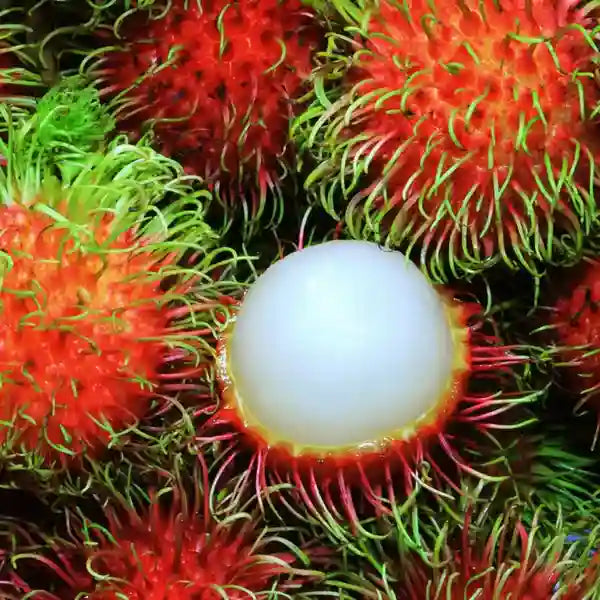
Rambutan Fruit Plant
Selling Size : Single Plant | Pot Included | Secure Packing
Rambutan, a tropical evergreen tree, is renowned for its sweet, juicy fruit covered in soft, spiky hairs. Native to Southeast Asia, it requires specific conditions to thrive. While it can be a challenging plant to care for outside of a tropical climate, with the right attention, you can successfully cultivate this unique tree.
Here,s a comprehensive guide care for rambutan :
Light
Full sun is best. Rambutan trees need a minimum of 6 to 8 hours of direct sunlight per day to grow and produce fruit.
Partial sun can also work, but it may result in less vigorous growth and a smaller yield.
For young trees or seedlings, a location with some protection from harsh, direct midday sun can be beneficial.
Water
Consistent moisture is crucial. Rambutan trees are shallow-rooted and are very sensitive to drought. The soil should be kept consistently moist but never waterlogged.
Water regularly, especially during dry periods. Small, frequent waterings are often better than one long, deep soak.
Mulch around the base of the tree to help retain soil moisture.
Soil
Well-draining, rich, and loamy soil is ideal. Rambutan prefers a slightly acidic soil with a pH between 5.5 and 6.5.
Avoid heavy clay soils that retain too much moisture, as this can lead to root rot.
When planting, amend the soil with organic matter like compost to improve drainage and nutrient content.
Temperature and Humidity
Rambutan trees are tropical heat lovers. They thrive in temperatures between 70°F and 95°F (21°C to 35°C).
They are very sensitive to cold. Temperatures below 50°F (10°C) can damage young growth, and anything below 40°F (4°C) can cause significant leaf drop and harm the tree.
High humidity is a must, with an ideal range of 75-80%. If you are growing a rambutan tree indoors, you may need to use a humidifier or mist the plant regularly.
Fertilizer
Rambutan trees are heavy feeders. They require regular fertilization throughout the year, especially during the growing season.
A balanced liquid fertilizer (like 20-20-20) can be applied regularly.
The specific fertilizer needs may change with the tree's growth cycle. For example, a fertilizer with a higher phosphorus content (15-30-15) can be used to promote flowering, and a different ratio (20-10-30) can help with fruit set.
Pruning
Pruning is typically minimal. The main goal is to remove dead, damaged, or diseased branches to maintain the tree's health and encourage good air circulation.
You can also prune to maintain a manageable size, especially if growing in a container or a greenhouse.
Other Care Tips
Pollination: Rambutan trees can be male, female, or hermaphrodite. For fruit production, you may need a male and female tree. However, many modern grafted cultivars are self-pollinating.
Pests and diseases: Keep an eye out for pests like fruit flies, borers, and mealybugs. Fungal issues like powdery mildew can also occur.
Fruiting: If grown from seed, a rambutan tree can take five to six years to produce fruit. Grafted trees can bear fruit much sooner, in as little as two to three years.

